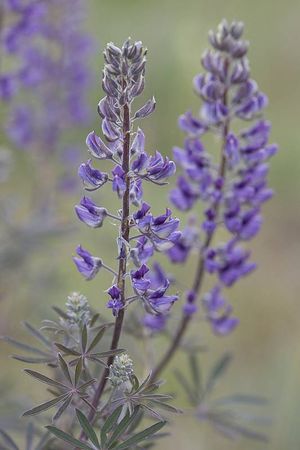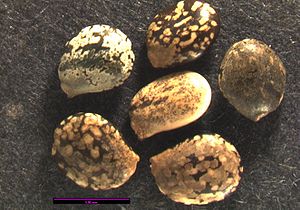Difference between revisions of "Lupinus albicaulis"
m (Tag: VisualEditor) |
(Tag: VisualEditor) |
||
| Line 25: | Line 25: | ||
===Plant Description=== | ===Plant Description=== | ||
| − | + | Native perennial herb. | |
| − | + | Leaves are palmately compound and composed of 5 to 10 narrowly oblong leaflets, each leaflet up to 7 cm. in size. Stems and both surfaces of leaves are covered in fine, whitish hairs.<ref>Bowcutt, F., & Hamman, Sarah. (2016). ''Vascular plants | |
| + | of the South Sound prairies'' (First ed.). Olympia, Washington: The Evergreen | ||
| + | State College Press.</ref> | ||
| − | + | Pappilonaceous flowers vary in color and may be white, yellow, purple, or blue and white. Flowered are whorled in racemes up to 4.5 dm long. Flowers have an upcurved glabrous keel, with slender wings which expose lower half of keel.<ref name=":0">Hitchcock, C. L., Cronquist, A., Giblin, D., & Legler, | |
| + | B. et al. (2018). ''Flora of the Pacific Northwest: an illustrated manual''. | ||
| + | Seattle: University of Washington Press.</ref> | ||
| − | + | Pods are 2-5 cm, silky.<ref>Teresa Sholars & Rhonda Riggins 2012, ''Lupinus albicaulis'', in Jepson Flora Project (eds.) ''Jepson eFlora'', /eflora/eflora_display.php?tid=76657, accessed on June 08, 2020</ref> | |
| − | + | ||
| − | <ref> | + | |
===Bloom Period=== | ===Bloom Period=== | ||
| − | May to July <ref name=" | + | May to July <ref name=":1">WTU Herbarium, Burke Museum, |
| + | & University of Washington. Retrieved from <nowiki>https://biology.burke.washington.edu/herbarium/imagecollection/taxon.php?Taxon=Lupinus%20albicaulis</nowiki></ref> | ||
===Distribution=== | ===Distribution=== | ||
| − | + | Puget Trough southwards, along West Cascades in Washington and Oregon, to California and western Nevada.<ref name=":0" /> | |
| − | + | ||
===Habitat=== | ===Habitat=== | ||
| − | Grasslands and prairies from the lowlands to moderate elevations.<ref name=" | + | Grasslands and prairies from the lowlands to moderate elevations.<ref name=":1" /> |
===Uses=== | ===Uses=== | ||
| − | + | Because of the capacity to fix nitrogen and grow quickly, ''Lupinus albicaulis'' is useful for soil stabilization and improving soil fertility.<ref>''Lupinus albicaulis''. Sevenoaks Native Nursery. <nowiki>http://www.sevenoaksnativenursery.com/native-plants/perennials-and-bulbs/lupinus-albicaulis/</nowiki>.</ref> | |
| − | + | ||
| − | + | ||
| − | + | ||
| − | + | ||
| − | + | Benefits hummingbirds and butterflies (larval host). Low palatability for browsing and grazing animals although small animals use it for cover. Birds eat seeds. Seeds toxic if eaten in large quantities. <ref>''Plant Database''. Lady Bird Johnson Wildflower Center - The University of Texas at Austin. (2007). <nowiki>https://www.wildflower.org/plants/result.php?id_plant=LUAL3</nowiki>.</ref> | |
===Seed=== | ===Seed=== | ||
Revision as of 13:49, 8 June 2020
- Latin Name: Lupinus albicaulis
- Family: Fabaceae
- Common Names: sicklekeel lupine
- Synonyms/Misapplications: L. albicaulis var. albicaulis, L. falcifer, L. quercetorum, L. wolfianus
- Codon: LUPALB
Contents
Taxonomy
| Lupinus albicaulis | |
|---|---|

| |
| Photo by Rod Gilbert, 2006, also featured on Main Page | |
| Scientific classification | |
| Kingdom: | Plantae |
| Subkingdom: | Tracheobionta |
| Phylum: | Spermatophyta |
| Subphylum: | Magnoliophyta |
| Class: | Magnoliopsida |
| Subclass: | Rosanae |
| Order: | Fabales |
| Family: | Fabaceae |
| Genus: | Lupinus L. |
| Species: | Lupinus albicaulis Douglas |
Plant Description
Native perennial herb.
Leaves are palmately compound and composed of 5 to 10 narrowly oblong leaflets, each leaflet up to 7 cm. in size. Stems and both surfaces of leaves are covered in fine, whitish hairs.[1]
Pappilonaceous flowers vary in color and may be white, yellow, purple, or blue and white. Flowered are whorled in racemes up to 4.5 dm long. Flowers have an upcurved glabrous keel, with slender wings which expose lower half of keel.[2]
Pods are 2-5 cm, silky.[3]
Bloom Period
May to July [4]
Distribution
Puget Trough southwards, along West Cascades in Washington and Oregon, to California and western Nevada.[2]
Habitat
Grasslands and prairies from the lowlands to moderate elevations.[4]
Uses
Because of the capacity to fix nitrogen and grow quickly, Lupinus albicaulis is useful for soil stabilization and improving soil fertility.[5]
Benefits hummingbirds and butterflies (larval host). Low palatability for browsing and grazing animals although small animals use it for cover. Birds eat seeds. Seeds toxic if eaten in large quantities. [6]
Seed
Seed sample from: 2011
Average Measurement: 5.7 x 4.4 x 2.1
Measurement Range: L: 5 - 6.5, W: 4 - 5, D: 1.5 - 2.5
Features
Color: Seeds are mostly off-white, tan, or gray with darker brown or tan mottling. Speckles tend to be heavier at seed edges leading to a darkened appearance.
Surface: Seeds smooth and glossy with some concave pitting.
Latitudinal Cross Section: elliptical ![]()
Longitudinal Cross Section: elliptical ![]()
Basic Explanations and Assumptions:
The dimensions for the seeds are length x width x depth. The location of the hilum is used as the base of the seed, and the length is measured from hilum to the opposite apex. Where a style is present, the length is measured from the hilum to the bottom of the style. Width is measured at a right angle to the length at the widest part. Depth is measured at a right angle to the intersection of height and width lines.
Measurements included are the mean average for each measurement of ten separate seeds.
All measurements in millimeters unless otherwise noted.
Photo Gallery
References
- ↑ Bowcutt, F., & Hamman, Sarah. (2016). Vascular plants of the South Sound prairies (First ed.). Olympia, Washington: The Evergreen State College Press.
- ↑ 2.0 2.1 Hitchcock, C. L., Cronquist, A., Giblin, D., & Legler, B. et al. (2018). Flora of the Pacific Northwest: an illustrated manual. Seattle: University of Washington Press.
- ↑ Teresa Sholars & Rhonda Riggins 2012, Lupinus albicaulis, in Jepson Flora Project (eds.) Jepson eFlora, /eflora/eflora_display.php?tid=76657, accessed on June 08, 2020
- ↑ 4.0 4.1 WTU Herbarium, Burke Museum, & University of Washington. Retrieved from https://biology.burke.washington.edu/herbarium/imagecollection/taxon.php?Taxon=Lupinus%20albicaulis
- ↑ Lupinus albicaulis. Sevenoaks Native Nursery. http://www.sevenoaksnativenursery.com/native-plants/perennials-and-bulbs/lupinus-albicaulis/.
- ↑ Plant Database. Lady Bird Johnson Wildflower Center - The University of Texas at Austin. (2007). https://www.wildflower.org/plants/result.php?id_plant=LUAL3.





